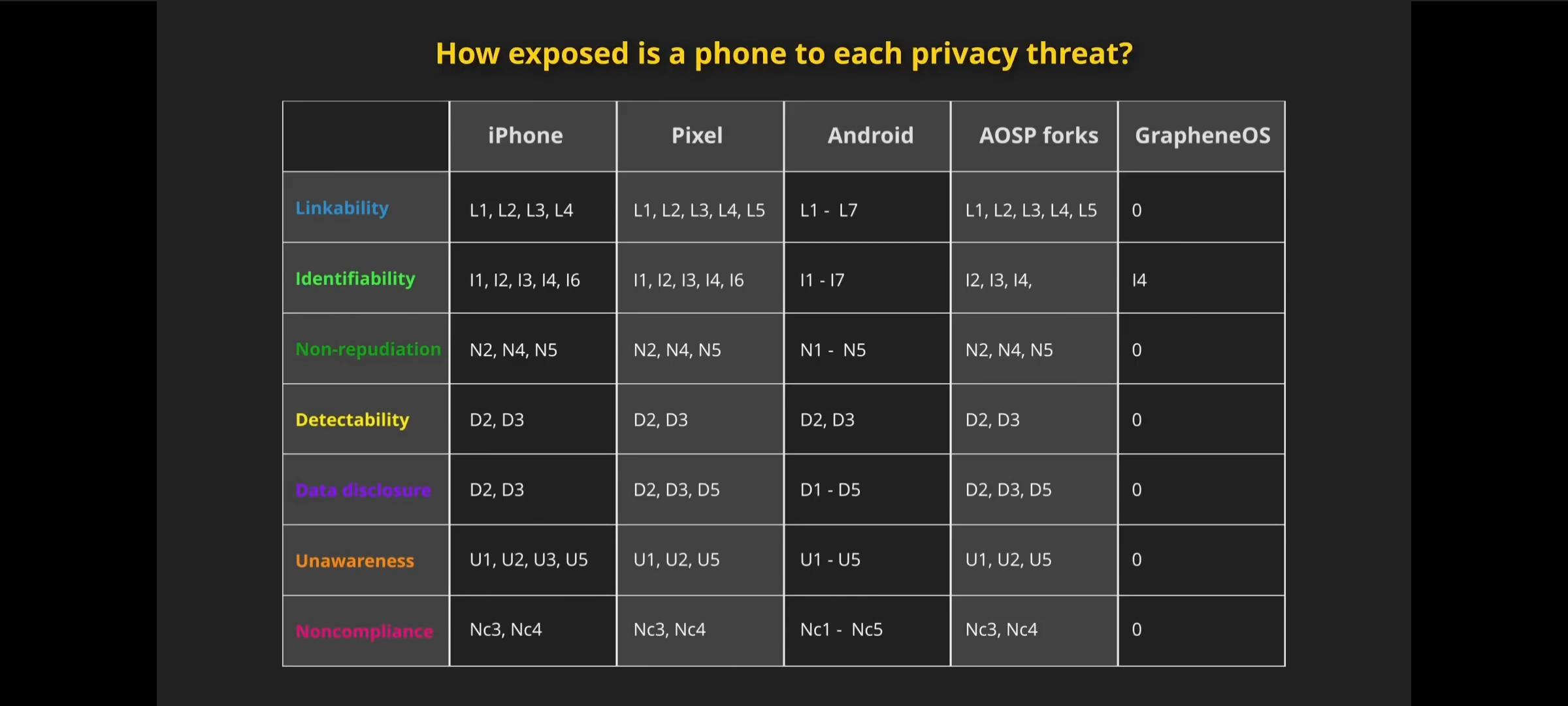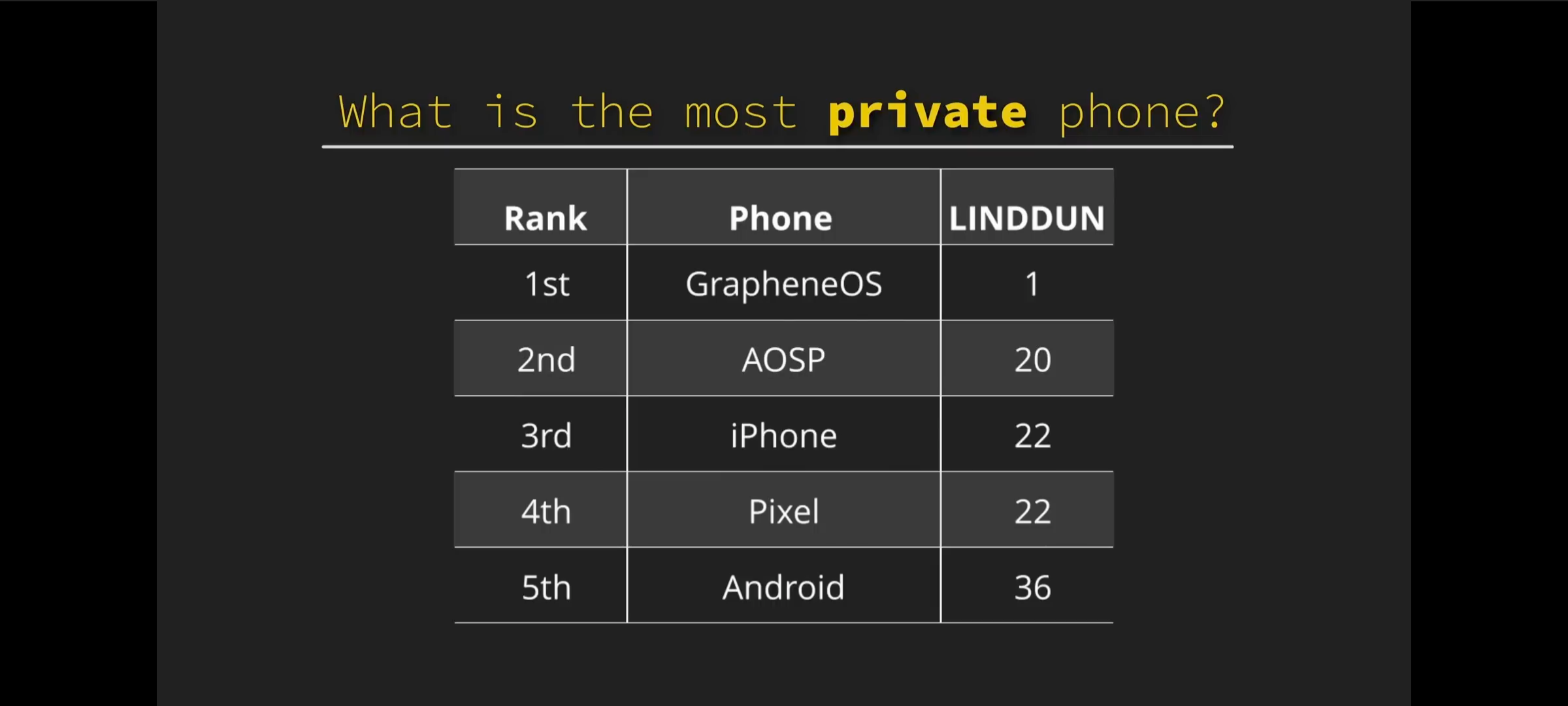TL;DW


LINDDUN card deck PDF for reference: https://downloads.linddun.org/linddun-go/default/v240118/go.pdf
TL;DR: Out of iPhone, Pixel, Android, AOSP forks, and GrapheneOS, the answer is GrapheneOS by a country mile.
Actually good point, added a TLDW screenshot of the summary
Four seconds of reading Vs a 16 minute video
If you want to hear the “why” part, that’s the 16m
GrapheneOS sometimes sacrifices privacy for security.
I had way more privacy related features and controls on a rooted LineageOS phone (which was obviously much less secure)
Such as? Been thinking of flashing GrapheneOS since I got a Pixel on the way.
Grapheneos has some unique features that simply no other mobile OS has. It is insane solid for security, but that does not make it lose anything in terms of privacy.
Starting with the fact that it comes with only the bare minimum of apps necessary for a functional mobile device (anything else you have to find, choose and install yourself).
Without digging too deep into the technical details of the software itself, the first "shit, I love this” factor for me begins with the storage scope and contacts scope. This is one thing I’m not willing to live without anymore. Pretty much every app, proprietary or otherwise, will ask for access to storage. With scopes you can provide access to a folder of your choice,even create a folder for each app if you want, effectively blocking every other app from potentially snooping into other apps storage.
The same holds true for contacts. Signal (Molly in my case) asks for access to contacts, but I have no need for that, as everyone I talk with over Signal is already there. But if someone new comes around, I give Molly access to that one contact and add them to Molly. My jmp.chat runs on Cheogram, and I only use it for my US and Canada contacts, so I don’t have to provide Cheogram access to anyone outside North America. Same thing with my VOIP service for work and so on.
The level of granularity achieved on permissions is just epic. I even tried to use stock pixel 4 days ago, kept it for 3 days, and had to roll back to Graphene last night because I couldn’t stand the constant nagging on the phone (and I disabled everything Google in it except the Play Store, for which I did disable everything but network).
I have no respect for Micay and his band of narcissistic developers with a god complex, but that doesn’t remove the fact that GrapheneOS is light years ahead of any mobile OS out there in terms of user control for privacy.
Please elaborate and/or [Citation needed].
This is incorrect. It strengthens both privacy and security in a lot of ways for an average user.
share your data with bad actors to prevent bad actors from getting your data
Rotary.
Tin cans and string
The tin can phone inherently provides end-to-end encryption. The acoustic signals, which are essentially longitudinal mechanical vibrations, travel directly through a taut string or wire. This physical medium ensures that the sound waves are converted into mechanical vibrations at the transmitting end and reconverted into sound at the receiving end, effectively eliminating any possibility of electronic eavesdropping or interception.
One of the most significant advantages of the tin can phone is its complete absence of a digital footprint. Unlike modern telecommunication devices that rely on electronic signals and data packets, tin can phone operates purely on mechanical principles. This means there are no digital records, metadata, or logs that can be hacked, traced, or subpoenaed.
The simplicity of the tin can phone renders it immune to a wide array of cyber threats. There are no software vulnerabilities, no firmware to update, and no risk of malware or ransomware attacks. The device’s operation is entirely analog, relying on the physical properties of sound waves and mechanical vibrations, making it impervious to digital exploits.
The physical nature of the tin can phone also contributes to its security. The string must be kept taut for effective communication, and any attempt to tap into the line would be immediately noticeable due to the loss of tension and degradation of sound quality. This provides a built-in tamper-evident feature, ensuring that any unauthorized access attempts are easily detected. On top of that, if someone attempts a man in the middle attack, you should be able to see it happening during the call and act accordingly before any sensitive data gets exposed.
The operational simplicity of the string and cans phone is another layer of security. With no complex interfaces or user authentication mechanisms, the risk of user error leading to security breaches is virtually nonexistent.
How? Literally uses the same phone lines that have always been not secure or private
No google, samsung, or apple services in the background or separate carrier operating system. Plus the audio is always worse on the old phones. Unless law enforcement is out to get ya, the only thing being tracked is what time and number called you, or whom you called and at what time.
Unless law enforcement is out to get ya
Seems like a huge oversight in privacy communities, which are frequented by people with state actor level threat models.
Nice username
Not really. A smartphone with a privacy-respecting OS and E2EE communication apps only is more secure. Though you can argue that it’s not really a phone if you don’t use the soter service.
I actually don’t agree with this video; and firmly believe it is more than a little biased.
For example, the Pixel, AOSP and Android are given several undeserved points due to lack of proper information or understanding of how certain features work. I imagine this is the case too for the iPhone; if a bit less so.
The review apparently doesn’t deep dive into settings or attempt to maximize privacy by turning off unwanted ‘features’ when settings switches are available to the user; nor does it assume that you set up accounts in as private of a manner as reasonably possible or toggle off as many default-on consent switches as needed.
While I would support scoring and dinging each case or instance for “Privacy Settings that don’t actually work”…this video really doesn’t do a lot of legwork and leans on the anecdotal evidence of scary news stories too much.
Worse was the fact that the entire video felt like they were shilling for Graphene OS; which is known to have a slightly unfriendly maintainer and community surrounding him to say the least.
No mention of Lineage or other privacy oriented Android ROMs were analyzed. AOSP too, was unfairly lumped in and dinged for specific points of the Default Pixel configuration…and yes there are major differences between AOSP and Pixel Android; even though Google tries to be less in-your-face invasive than the other OEMs. Not enough credit is given for the “On-Device” smart features implemented properly on the Pixels.
Out of personal experience; I’d actually rate a proper Lineage OS install of 4 whole Android versions ago to be more private than stock. Not quite as private as Graphene; but not quite as invasive and much more enforcing of privacy. The debloating provided by a clean AOSP-like ROM, such as Lineage, as opposed to a “Stock Android” configuration from a major OEM is stark.
Most importantly I personally feel that the privacy model chosen for the video is far too thickly detailed for an average person. Most of the privacy concerns listed on each card contained concern points that might only tangentally apply or don’t apply at all to mobile phones. The way that each card was scored and applied felt low effort. None of the points on any of the card(s) were weighted with average users in mind.
I really hope someone goes into a much deeper dive; this video is basically clickbait that parrots the commonly parroted advice in the privacy community; which isn’t even good advice, it’s just ‘One-Size-Fits-All’ style advice which gives the user no room to make necessary ‘Privacy vs Convenience’ tradeoffs that they themselves could have made if they understood proper threat modelling.
Worse was the fact that the entire video felt like they were shilling for Graphene OS; which is known to have a slightly unfriendly maintainer and community surrounding him to say the least.
Correction, the developers, not the community, are flat out pricks (not “slightly unfriendly”), but this does nothing to remove how amazing the OS is for anyone wanting to remove themselves from all the mainstream garbage in the mobile devices scenario while being able to keep productivity with a few workarounds.
Out of personal experience; I’d actually rate a proper Lineage OS install of 4 whole Android versions ago to be more private than stock. Not quite as private as Graphene; but not quite as invasive and much more enforcing of privacy. The debloating provided by a clean AOSP-like ROM, such as Lineage, as opposed to a “Stock Android” configuration from a major OEM is stark.
You will see me speak about Grapheme as if it was the Holly grail of mobile OSs, and that is because I actually move between CalyxOS, stock android, grapheme and Lineage every few months, and the fact remains that you have less than half of the control on your privacy you can get on anything other than Graphene. Additionally, show me one mobile OS that has less bloat then Graphene.
Every time I see posts slamming GrapheneOS over the toxic community (which it is not) or the devs (who are extremely toxic in my opinion), all I see is butthurt overly a sensitive individuals that are looking at the wrong thing. GrapheneOS is what Android should be, it’s that simple. All these rants about how toxic x or y is only serves to keep people starting in the privacy or security (or both) path away from what is effectively a huge leap from being invaded and helpless in the current tech and surveillance scenario to having near-complete control over their digital lives.
Correction, the developers, not the community, are flat out pricks (not “slightly unfriendly”), but this does nothing to remove how amazing the OS is for anyone wanting to remove themselves from all the mainstream garbage in the mobile devices scenario while being able to keep productivity with a few workarounds.
Yep. I’m willing to deal with a prick developer who’s taking this on their shoulders. Theyve really produced something incredible with GrapheneOS. I’m not willing to deal with the pricks who sell my data to anyone and everyone. Especially pricks who have had contracts with various intelligence agencies.
Precisely my point. That’s the smart stand in my opinion.
lol you are so wrong.
On what exactly?
TL;DR: I think this video oversimplifies the analysis according to the cards and gives Graphene OS undue weight without going into sufficient detail as to why each scored under each category.
I’d actually rate a proper Lineage OS install of 4 whole Android versions ago to be more private than stock.
Its always the lineageos stans that can’t take the truth.
Would a research paper change your mind?
https://infosec.exchange/@rene_mobile/113431029855652363
According to this table, Google Pixels beat other devices listed there by far. Even Samsung S-series doesn’t look good
What about a security expert?
Overall, LineageOS does not leave a privacy-friendly or truly secure impression
Somehow that posted as an entirely empty comment… Here’s what was supposed to be in it:

Your first comment was right: no phone
Which of these smart phones lets me have a headphone jack… ’cause that is how I will choose. I can patch software & be wary about how I use the device, but I can’t just add I/O to the hardware. Until the Pixel brings back the jack, it is dead to me.
I got a Nokia XR20 because of this. Also waterproof and rugged. A phone that needs a case to survive the hairless monkeys dropping it is a design failure and completely unacceptable.
Just wish I could use proper software with it.
None basically. There’s a Sony phone has LineageOS (including +microg variant) support, but it’s not ideal either.
And that is exactly what I am running—and without regret since the OEMs are screwing over users just to sell branded Bluetooth earbuds whose batteries will die & not be repairable in a year for you to buy another set. I will not participate in this.
The Apple TypeC-to-3.5mm dongle is cheap and measures better than most phones in terms of audio quality.
If you use mostly the same pair of headphones, you can attach the dongle to them and use them just like before. But it’s annoying if you use many different headphones and have to either move the dongle from one set to another or buy multiple dongles.
I gave up on avoiding phones without a headphone jack.
Dongles create additional & unnecessary points of failure in your setup (sometimes additional stress on the USB jack too which is usually your only I/O port (which is also making you choose charging or power)). Personal devices that play media need this standard jack that has existed for decades—& I refuse to play ball with these OEMs hurting customers.
Spoiler: It’s a banana phone.
I didn’t watch the video but I don’t think there is any phone that lets you avoid having your location tracked. If there is wifi near where you want to use the phone, you could run a voip client on on a wifi-only tablet, perhaps.
I’ve been wondering whether satellite communications gizmos with no GPS allow any type of precise location tracking from the satellite. I’ve been interested in this, which lets you exchange text messages at fairly low cost (about 2 cents per 50 byte unit). Besides possible privacy advantages, it also lets you communicate where there is cell coverage:
Well technically there is: pixel + graphene os + airplane mode with wifi only, from the video
Added a TLDW summary to the post if you want to take a peek
Ok but wifi only isn’t really a phone?
Can you call on wifi? Yes (voip numbers like you said). I think that’s a phone.
Obviously you need to be connected
Then my laptop is a phone? It’s sort of a phone but it doesn’t connect to the phone network, so only sort of. Since it needs a wifi signal it’s not so mobile either.
What is the most private phone? Take a visit to a Google property and curb stomp your privacy to find out!
if you have a xiaomi phone with GrapheneOS, NEVER, REALLY, NEVER!! relock the bootloader
How did you install Graphene in the first place?
i didn’t, but it is possible, altrough, not straightforward and requires some knowledge. I have an aosp-based custom rom, vanilla InfinityXOS (previously Superior-Extended). I have Poco X3 Pro btw. And because of how bootloader unlocking works, it is not a two-way process on xiaomi devices. Once you unlock it, there is no going back. If you try, it will hard brick and you can get a JTAG or something to reprogram the soc capacitors (doesn’t worth trying, there isn’t any single known xiaomi phone that didn’t brick upon an attempt to relock the bootloader)
That’s really cool! And yeah the bootloader locking checks out with into from other guides.
That unbricking talk flies over my head on the other hand, it sounds like one of those fake tech speaks to my uncultured self lolit is actually real
btw some xiaomi devices support edl mode EVEN in hardbricked state so Mi Flash tool might work too
Sorry, I wasn’t saying it wasn’t, I just found it funny, I do trust you know what you’re talking about, had no reason to doubt you
That’s the case with most non-Google phones
Why?
it will brick
I agree with this. However the very latest Pixels (with the stock ROM) might be a bit more invasive than the phones by an OEM like Motorola or Nokia.
What is LINDDUN?
Usually I tend to avoid sarcastic responses, but since no one mentioned it, how about the game of Telephone?
A flame of xylophone?
i use a customization-oriented aosp custom rom (vanilla version, no google). It is already very private but there is more private than this, but that seriously restricts usability and visual appeal













